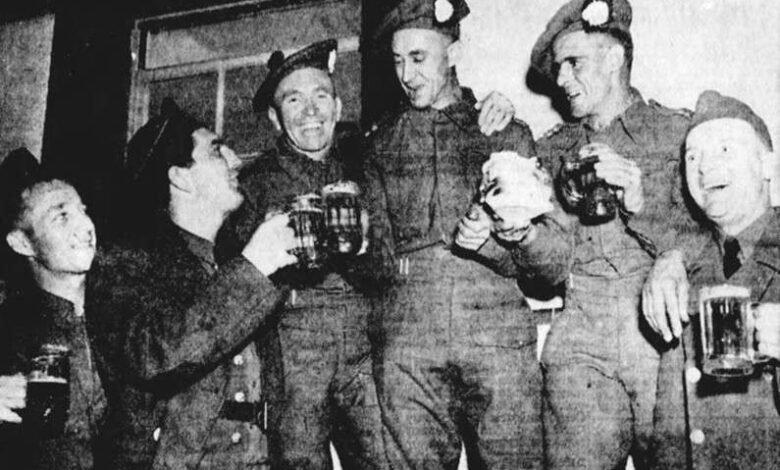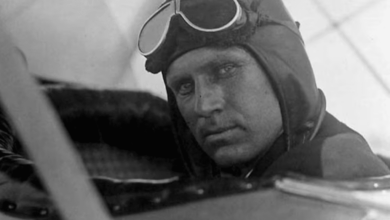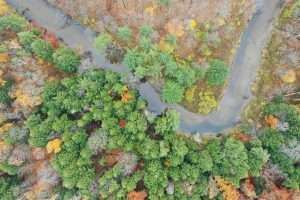1942: When New Rochelle Welcomes the Cameron Highlanders


 There can’t be many who will recall how we, the residents of New Rochelle, hosted two battalions of British infantry in 1942. This is the story of a Scottish unit of the British Army that had the good fortune – in the midst of war – to be hosted by the many good and caring residents of New Rochelle, New York, while their troopship was being serviced in the Port of New York City.
There can’t be many who will recall how we, the residents of New Rochelle, hosted two battalions of British infantry in 1942. This is the story of a Scottish unit of the British Army that had the good fortune – in the midst of war – to be hosted by the many good and caring residents of New Rochelle, New York, while their troopship was being serviced in the Port of New York City.
The Regiment had been raised in 1793 as the 79th Regiment of Foot and following a series of renaming, redesignating and reconstitution they eventually became a part of the Territorial Force as the 4th Battalion, The Queen’s Own Cameron Highlanders.
When World War II broke out for the British in September 1939, the 4th Battalion, The Queens Own Cameron Highlanders, were mobilized at Inverness, Scotland, and joined the 51st (Highland) Division. They served with the B.E.F., British Expeditionary Force, North France, from early 1940 until driven back from the Somme by a large and strong German force. The division was ultimately forced to surrender at St. Valrey-en-Caux.
The new 4th Battalion was reconstituted the following month and in August 1940 sailed for the Dutch West Indies to provide security duty for the oil fields. They arrived in this country in February 1942, enroute home to the UK from Aruba. Their ride to New York was quite pleasant and, as quoted by one of the Scots, was “a beautiful bed in a Pullman with white linen and a servant to lay it all out at night”.

 As they disembarked their ship, the crowd of New Yorkers began to grow to the sound of the bagpipes from their band. Both regiments, the 4th Battalion Queens Own Cameron Highlanders and the 2nd Battalion Kings Shropshier Light Infantry were billeted at Fort Slocum, on David’s Island in New Rochelle; a small Army Post a few hundred yards offshore from the city, which was the nearest “liberty town” for any off-duty troops. They took advantage of their fortunate posting at New Rochelle.
As they disembarked their ship, the crowd of New Yorkers began to grow to the sound of the bagpipes from their band. Both regiments, the 4th Battalion Queens Own Cameron Highlanders and the 2nd Battalion Kings Shropshier Light Infantry were billeted at Fort Slocum, on David’s Island in New Rochelle; a small Army Post a few hundred yards offshore from the city, which was the nearest “liberty town” for any off-duty troops. They took advantage of their fortunate posting at New Rochelle.
One young student offering to help the troops move in, was thanked and complimented by a kilted officer with, “You’ll be a man afore your mither”.
As I recall, the visiting soldiers were taken into the hearts and homes of the American public. They were treated to private parties, dinners, sightseeing tours, and theater parties and tickets. The troops seem to integrate well, particularly those Scottish troops who had luckily found local residents who knew friends or relatives back home. Many soldiers were literally just taken off the streets and brought home for dinner or just given tickets for a show.
Though the hospitality was intended to be extended and shared by all, the Scottish soldiers were particularly spoiled by the Fraternal Lodge of Clan Bruce, made up of expatriated Scots living in New Rochelle. Clan Bruce managed to entertain the group through the USO, once or twice. The first being at the Knights of Columbus Hall where about one thousand people attended.
Dancing had to be limited to soldiers because of the crowds, but one can be sure that others managed to squeeze their way in. The music and entertainment was provided by a Stamford, Connecticut pipe band.

 And the ladies of the Clan were not to be out done. The Marjorie Bruce Lodge of the Daughters of Scotia held an open house tea party at Otten Hall following one of their regular meetings. They were entertained by Scottish songs from the men. One even played solos on his harmonica. Mrs. Alex Munro was in charge of the arrangements.
And the ladies of the Clan were not to be out done. The Marjorie Bruce Lodge of the Daughters of Scotia held an open house tea party at Otten Hall following one of their regular meetings. They were entertained by Scottish songs from the men. One even played solos on his harmonica. Mrs. Alex Munro was in charge of the arrangements.
The Mayor of New Rochelle, Stanley Church, also had the opportunity to greet the troops as he was escorted to his platform by two bagpipers. “We are delighted to have you and are getting ready to fight alongside with you”.
The attraction and popularity of the troops continued through their two-month stay in Westchester County, especially with that of the pipe band of the Camerons. Well do I, then a twelve-year-old 7th grade student at the old Trinity School, recall the day the band appeared and performed for us kids.
Trinity Place was blocked off from traffic at both ends and the sidewalks on both sides were lined with children. Whether it was the cold or part of the program, the bagpipers moved inside and finished on the stage. We students sought autographs from the band.
The autographs I obtained that day lasted – pasted to my bedroom walls – until my mother had enough. One observant Jock commented that “we were near smothered by autograph seekers.” But if you were lucky enough to obtain one of the Cameron’s regimental bonnet badges, you had achieved a real prize.

 The provision of one or two drinks would usually do it. My bonnet badge came from a Jock through Miss Laura Anderson of King’s Highway, a family friend. To this day, I still have the badge with a Cameron tartan mounted behind, with a KSLI bugle badge along with it.
The provision of one or two drinks would usually do it. My bonnet badge came from a Jock through Miss Laura Anderson of King’s Highway, a family friend. To this day, I still have the badge with a Cameron tartan mounted behind, with a KSLI bugle badge along with it.
Because of restrictions of non-military personnel at Fort Slocum, the crowd was much smaller for a Retreat Ceremony held one day at the fort that just a few privileged attended. The Camerons Pipe Band, the Shropshiers Bugle Band and a US Army Band from the Fort, all participated. They say it was a spectacular show, never seen before by Americans and very much appreciated.
The band must have had a dinner engagement in White Plains one night because I saw them parading down Mamaroneck Avenue one Saturday evening in dress uniform (though not in full dress, spats yes, but no feather bonnet nor full plaid). The following day they held Church Parade at the First Presbyterian Church, Pintard Avenue, New Rochelle. Reverend Dr. Robert R. Hartley invited the Cameron Chaplin to lead the service.
Bagpipes are affected by temperature and due to the change in climate from the warmth of the West Indies to the cold of the north, the pipes had to hold most of their performances in the afternoon.
Most any morning, if you timed it right, you’d catch a detail of troops along with their kilted Sergeant on a route march up North Avenue from the Shore Road. They’d have to turn left to head back to the fort rather than continue into Main Street traffic. We kids would march (or walk) right along beside them, but we’d turn off at Union Street and head to the old Trinity School.
One day I was full of questions and the Sergeant shared my inquiries with his troops and got a good laugh at my ignorance, “The wee laddie wants’ ta know why I wasna’ wearin’ ma sporran today.” Then another added, “You’d speer the breeks of a heiland mon.” I needed my old granny to translate that one for me.

 Dinner dances and dancing of all sorts became quite popular with the troops. Depicted here is Miss Flora Hamilton’s Hornpipe accompanied by two pipers from the band, Pipe Major Donald McFee and Sergeant George MacLennan.
Dinner dances and dancing of all sorts became quite popular with the troops. Depicted here is Miss Flora Hamilton’s Hornpipe accompanied by two pipers from the band, Pipe Major Donald McFee and Sergeant George MacLennan.
At a USO function, Miss Hamilton was joined by Mildred Baxter, Ann Pollack, Evelyn Baxter and Mrs. Fairweather in performing the Sword Dance and Highland Fling. One of the pipers also performed a hornpipe but did it his way; first removing his uniform jacket, shirt and heavy boots, then danced in his stocking feet. Jack Skipp’s orchestra played throughout.(Image 6, “Miss Flora Hamilton dancing…”)
At a tea dance held by the British War Relief Society, the Scottish jocks and British troops proved themselves quite adapt to La Conga, a dance quite popular in U.S. at the time. Approximately 400 people attended. Mrs. Herbert Walker, Charles Shaw, Harriet Hay, Charles Brooke, Ralph Robertson, Andrew Wilson, Beth Stewart, James Lee and Mrs. John Mowat were among the many ladies hosting. Skipp donned his uniform for the occasion, having served with the Gordon Highlanders during the First World War.
As early spring began to settle over New York, the troops began to prepare for their embarkation home. The Regimental commanders said their thanks to the people of New York, and most especially the residents of New Rochelle, for their very kind acceptance of the unexpected guests and the wonderful hospitality that had continued throughout their stay.
Lieutenant Colonel Ian Begg, the Scottish Battalion Commander, noted, “The Highland Battalion recently stationed in the New York area wishes to thank the many friends they have made for their hospitality and
welcome. Never in the history of the Regiment have we enjoyed such friendship.”

 Similarly, Lieutenant Colonel Hughes Hallett of the Shropshiers, stated that he “Wishes to express our very sincere gratitude to all those who extended such boundless hospitality that has never been exceeded in our regimental history. They leave the US with most pleasant memories of friends and allies they have made”.
Similarly, Lieutenant Colonel Hughes Hallett of the Shropshiers, stated that he “Wishes to express our very sincere gratitude to all those who extended such boundless hospitality that has never been exceeded in our regimental history. They leave the US with most pleasant memories of friends and allies they have made”.
By March 1942, the 4th Camerons had returned to Inverness, Scotland for reassignment, the 2nd Battalion Cameron Highlanders had been lost in North Africa at the Siege of Tobruk, and the 4th Battalion continuing its checkered existence had been designated the 2nd Battalion, The Queen’s Own Cameron Highlanders. This new 2nd Battalion was now posted to the 15th Scottish Division and served with them in Greece and Italy until they were disbanded.
After their historic visit to New Rochelle, the Colonels returned to their Regiments. The battalions returned to the war. And the City of New Rochelle could relax until the next batch of allied soldiers arrived from the Burma-India Theater of War, when the residents of the city could plan their next welcome.
Richard H. Crawford was born, raised, and educated in New Rochelle, NY, graduating from Isaac E. Young High School (’57). He served in the United States Marine Corps and retired from the Westchester County Police. Crawford served in numerous Westchester County pipe bands of distinction and is a recognized authority on military pipers of Scotland. He currently lives in Peekskill, New York. His regimental references for this piece include Queen’s Own Highlanders, (Seaforth and Camerons), by Angus Farrie, The 79th News, February and March 1942, and he received technical support on this article from James O’Shaunesey and Janet Reidy.
Illustrations, from above, from New Rochelle’s The Standard Star newspaper, February and March 1942: A British Tommy, an American GI and a 79th Jock; A group of Jocks and friends toasting the regiment; Mrs. Fairweather and a group of ladies of the Marjorie Bruce Lodge; a Cameron Highlander’s Bonnet (hat) Badge; Miss Flora Hamilton dancing the Sailors Hornpipe accompanied by Pipe Major Donald McFree and Sergeant George Mclennan; A group of young Shropshire soldiers sampling an American GI chow line.
Source link




